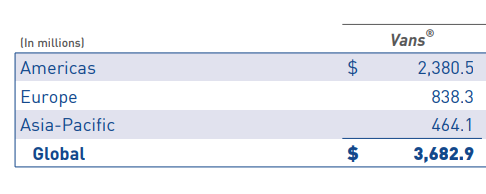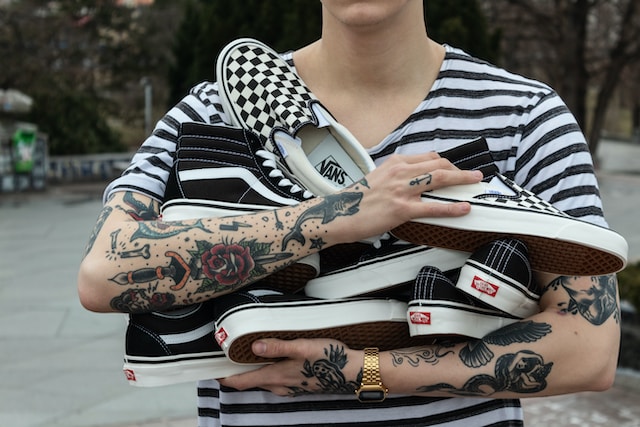Before we dive deep into the SWOT analysis, let’s get the business overview of Vans. Vans is a popular American apparel company known primarily for its footwear. The company was established in Anaheim, California, in 1966 by brothers Paul Van Doren and James Van Doren, along with partners Gordon Lee and Serge D’Elia. The Van Doren Rubber Company, as it was initially known, uniquely started manufacturing shoes and selling them directly to the public.
The company grew significantly throughout the decades and solidified its cultural influence during the 70s and 80s, especially within the skateboarding community. Vans’ rugged make-up and sticky sole made them ideal for skateboarding, leading the company to create the #95, now known as the Era, a shoe designed specifically for skateboarding.
Vans also created the Slip-On, another iconic style still widely popular today. The shoes gained more public visibility after being featured in the 1982 film “Fast Times at Ridgemont High” and have since become a staple of American footwear.
In 2004, Vans became a part of VF Corporation, a global apparel and footwear company that owns other major brands like The North Face, Timberland, and JanSport. Vans has continued to grow under this ownership, expanding its product range to include apparel and accessories and sponsoring numerous sporting and music events.
As of my knowledge cutoff in September 2021, Vans operates retail stores across the globe and sells products online, with a significant presence in North America, Europe, and Asia. Their shoes and apparel remain a mainstay in youth culture, particularly within the skateboarding, snowboarding, BMX, and surfing communities, as well as in the broader worlds of fashion and streetwear.
The company has maintained its commitment to the youth and creative culture, supporting events and initiatives around music, arts, and sports. Like many apparel companies, sustainability and responsibility have also been a growing focus for Vans as it seeks to reduce its environmental footprint and contribute positively to communities.
Financial Performance: Vans brand global revenues decreased 12% in Fiscal 2023 to $3.68bn from $4.16bn in FY22. The overall decline in Fiscal 2023 was primarily attributed to a 10% decrease in the Americas region, driven by the performance in the direct-to-consumer channel. Region-wise segmentation in FY23 was as follows:

Here is the SWOT analysis of Vans
A SWOT analysis is a strategic planning tool used to evaluate the Strengths, Weaknesses, Opportunities, and Threats of a business, project, or individual. It involves identifying the internal and external factors that can affect a venture’s success or failure and analyzing them to develop a strategic plan. In this article, we do a SWOT Analysis of Vans.
SWOT Analysis: Meaning, Importance, and Examples
Strengths
- Brand Recognition and Reputation: Vans is a globally recognized brand with a strong reputation, particularly among youth and creative cultures. Its long history and association with skateboarding and other extreme sports give it a unique position in the market.
- Strong Cultural Ties: Vans’ historical ties to the skateboarding, snowboarding, BMX, and surfing communities remain a major strength. The brand is not just seen as a product provider but as an integral part of these communities, sponsoring events and supporting athletes.
- Diverse Product Line: Vans provides a broad range of products, from classic footwear to apparel and accessories. This diversity allows Vans to appeal to a wider customer base.
- Strong Retail and Online Presence: Vans has a strong retail presence with stores worldwide and a robust online platform. This gives them a wide reach and makes their products easily accessible to customers around the globe.
- Backing of VF Corporation: Being part of the VF Corporation, a global apparel and footwear company, provides Vans with substantial resources and a strong support network.
- Fashion-forward and Collaborative Approach: Vans frequently collaborates with designers, artists, and other brands to create limited-edition product lines. This keeps their offerings fresh, appeals to a wide range of consumers, and enhances fashion credibility.
- Community Engagement: Vans’ commitment to engaging with and giving back to communities is another strength. They support music, arts, sports events, and various social causes. This positions the brand as socially responsible and helps foster loyalty among consumers.
- Sustainability Initiatives: Like many other companies, Vans has been making efforts to reduce its environmental footprint. Consumers are increasingly looking for environmentally-friendly products and sustainable business practices, an important strength.
Weaknesses
- Reliance on the Skate Culture: Vans’ strong ties to skateboarding and extreme sports cultures are double-edged. While they have contributed to the brand’s success, these associations may also limit its appeal to a broader audience or for other uses, like formal or professional wear.
- High Price Point: Vans products often have a relatively high price point compared to other sportswear or casual wear brands. This may deter cost-conscious consumers, particularly in emerging markets.
- Intense Competition: The footwear and apparel market is highly competitive, with numerous brands offering similar products. Competing against powerhouses like Nike and Adidas, which have larger advertising budgets and extensive celebrity endorsements, is challenging.
- Risk of Overexposure: Vans’ widespread popularity and broad product line could potentially lead to overexposure, which might diminish its ‘cool’ factor among core customers who value exclusivity and uniqueness.
- Supply Chain Complexity: Being a global company selling diverse products, Vans has to manage a complex supply chain. Disruptions in this supply chain, caused by factors like the COVID-19 pandemic or geopolitical tensions, can significantly impact the business.
- Sustainability Challenges: Despite its efforts, Vans, like many companies in the apparel industry, faces challenges in becoming fully sustainable. Manufacturing processes for footwear and clothing often involve high water use, chemical dyes, and generated waste. There may also be issues with ensuring fair labor practices throughout the supply chain.
- Fast Fashion Trend Risks: Fashion trends can change rapidly, and failing to keep up with these trends can impact sales.
Opportunities
- Expanding into New Markets: Emerging markets, especially in Asia and Africa, present significant growth opportunities. Vans can expand its retail and online presence in these markets, adapting its marketing strategy to align with local consumer preferences and purchasing power.
- Increasing Online Sales: The rise of e-commerce offers a huge opportunity. While Vans already has an online sales platform, further optimizing its online shopping experience, enhancing digital marketing efforts, and expanding into platforms like mobile commerce could drive significant growth.
- Sustainable Products: As consumers become increasingly concerned about environmental sustainability, Vans could expand its range of eco-friendly products. This could include shoes made from recycled materials, organic cotton clothing, or a shoe recycling program.
- Health and Fitness Trend: As the trend towards a more active lifestyle continues, Vans could expand its product line to cater to a broader range of sports and fitness activities beyond its traditional focus on skateboarding and extreme sports.
- Personalized Products: The demand for personalized or customized products is growing. Offering customers the ability to customize their shoes or clothing could differentiate Vans from its competitors and increase consumer engagement.
- Technological Innovation: Innovations in footwear technology, such as advanced materials for improved comfort or performance, allow Vans to enhance its product offerings.
- Collaborations and Partnerships: Collaborations with other brands, artists, or influential figures can help Vans to reach new audiences, boost its brand image, and drive sales.
- Community Initiatives: Vans can further invest in initiatives that support the communities it serves, such as arts, music, and sports programs for youth. This can boost brand loyalty, positive PR, and long-term customer relationships.
Threats
- Intense Competition: The footwear and apparel market is highly competitive, with many brands, including giants like Nike and Adidas, competing for the same target audience. These competitors have significant resources and can impact Vans’ market share.
- Economic Conditions: Economic downturns or periods of uncertainty can reduce consumer spending, especially on discretionary items like fashion footwear and apparel. This could significantly impact Vans’ sales.
- Fast-changing Fashion Trends: In the fashion industry, trends can shift rapidly. It could lose relevance and market share if Vans fails to anticipate or adapt to these changes quickly enough.
- Global Supply Chain Disruptions: Political instability, trade wars, pandemics, or natural disasters can disrupt global supply chains. Since Vans sources and distributes its products globally, it is vulnerable to these disruptions.
- Shifts in Consumer Preferences: Consumers increasingly seek products that align with these values as they become more environmentally and socially conscious. If Vans fails to meet these expectations, it could impact its brand image and sales.
- Counterfeit Products: The popularity of Vans’ products makes them a target for counterfeiting. This could lead to lost sales and damage to the brand’s reputation.
- Regulatory Changes and Compliance: Changes in regulations related to trade, manufacturing, labor rights, or environmental standards in the countries where Vans operates could increase costs or require changes to business practices.











